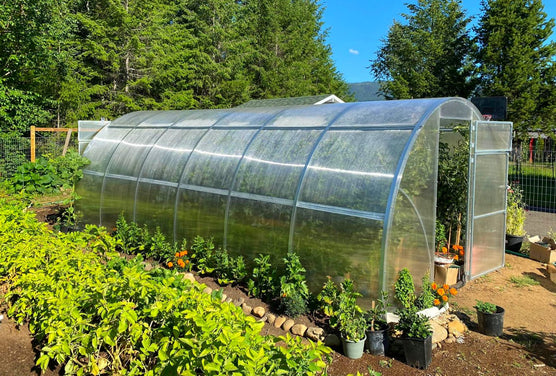Structure Desires, Growing Eco-friendly: Monarch Greenhouse Builder Utah at Your Service
Wiki Article
The Future of Greenhouses: Developments in Sustainable Agriculture
Are you interested concerning the future of greenhouses and just how they are changing lasting farming? From sophisticated environment control systems to vertical farming strategies, water-efficient irrigation approaches, renewable energy integration, and wise information analytics, these developments are transforming the way we expand our food.Advanced Climate Control Solution
To accomplish ideal growing problems, you can depend on the improvements in greenhouses with advanced climate control systems. These systems have transformed the way we grow plants, giving a controlled atmosphere that is helpful to plant growth. With these cutting-edge systems, you can now control temperature, moisture, light degrees, and even carbon dioxide concentrations to create the excellent problems for your plants to flourish.One of the vital attributes of these advanced environment control systems is their ability to control temperature level. By utilizing sensing units and automated controls, the greenhouse can adjust the temperature based on the certain requirements of the plants. This ensures that they are never ever exposed to extreme warmth or cool, which can be destructive to their growth.
Humidity control is one more critical aspect of these systems. By preserving the optimal moisture levels, you can prevent problems such as mold, mold, and condition from influencing your plants. These systems can also manage the quantity of light that gets to the plants, making sure that they obtain the optimal quantity for photosynthesis.
In addition, advanced climate control systems can even manipulate CO2 focus. By enhancing the degrees of CO2 in the greenhouse, you can improve plant development and efficiency. This is specifically useful in areas with reduced natural carbon dioxide levels.
Vertical Farming Techniques
One crucial upright farming strategy is using stacked growing systems. Piled growing systems are commonly made use of in urban areas where area is limited.One prominent method is known as vertical hydroponics, where plants are grown in nutrient-rich water without soil. This technique is extremely effective as it reduces water use by up to 90% compared to traditional farming approaches. Furthermore, given that the plants are expanded inside your home, they are secured from illness and parasites, reducing the requirement for pesticides.
Another strategy is aeroponics, which includes putting on hold the plant roots in a mist or air setting. This method enables ideal nutrient absorption and oxygenation, resulting in faster development and higher yields. Aeroponics likewise makes use of less water than typical farming and can be executed in upright systems, making it a preferred selection for vertical farming.
Water-efficient Irrigation Approaches
Making best use of water preservation is important when it pertains to executing water-efficient watering techniques in lasting farming. With worldwide water shortage ending up being a pushing concern, it is vital to create cutting-edge techniques that optimize water usage in greenhouse operations.One encouraging technique is drip irrigation, which supplies water straight to the plant roots, decreasing waste and evaporation. By utilizing a network of tubes with small emitters, water is used gradually and precisely, guaranteeing that plants receive the required moisture without excess runoff.
An additional reliable strategy is using soil wetness sensing units. These tools determine the dampness content in the soil and give real-time information to farmers. By keeping an eye on the dirt's wetness degrees, farmers can precisely establish when and just how much water to apply, stopping over-irrigation.
Additionally, the execution of rain harvesting systems is acquiring popularity in greenhouse farming. Collecting rain from roofs and saving it in containers allows farmers to use this natural source for irrigation objectives, decreasing reliance on typical water sources.
Last but not least, the fostering of automated watering systems can substantially boost water effectiveness. These systems utilize sensing units to find dirt moisture degrees and climate condition, changing watering timetables appropriately. By enhancing water use based upon real plant requirements, these systems can minimize water waste and promote lasting farming practices.
Renewable Energy Assimilation
Sustainable power combination in greenhouses offers several benefits, consisting of lowered running prices and reduced reliance on non-renewable power sources. The produced power can then be utilized to run numerous procedures within the greenhouse, such as lights, ventilation, and heating systems. These artificial grass for sale generators harness wind power and transform it right into electricity, which can be used to supplement the power needs of the greenhouse.Smart Data Analytics and Automation
To improve the efficiency of your greenhouse procedures and maximize source utilization, think about carrying out wise data analytics and automation. Smart information analytics involves accumulating and evaluating information from numerous sensors and gadgets within your greenhouse.
This can include automating the control of lighting, ventilation, read the article irrigation systems, and nutrient shipment. By automating these procedures, you can guarantee that your plants obtain the ideal conditions and nutrients at the appropriate time, without the requirement for constant hands-on intervention.
In addition, wise information analytics and automation can function with each other synergistically. The information gathered by sensors can be used to notify automated systems, enabling them to make real-time modifications based on the present conditions. This assimilation of data analytics and automation can lead to a lot more reliable and precise source allotment, inevitably resulting in greater returns and far better crop quality.
Conclusion
In final thought, the future of greenhouses in sustainable farming looks encouraging. With sophisticated environment control systems, vertical farming strategies, water-efficient irrigation methods, and sustainable power integration, greenhouses are ending up being a lot more environmentally pleasant panicum virgatum heavy metal and effective.
By optimizing water use based on actual plant demands, these systems can minimize water waste and promote lasting farming practices.

Report this wiki page